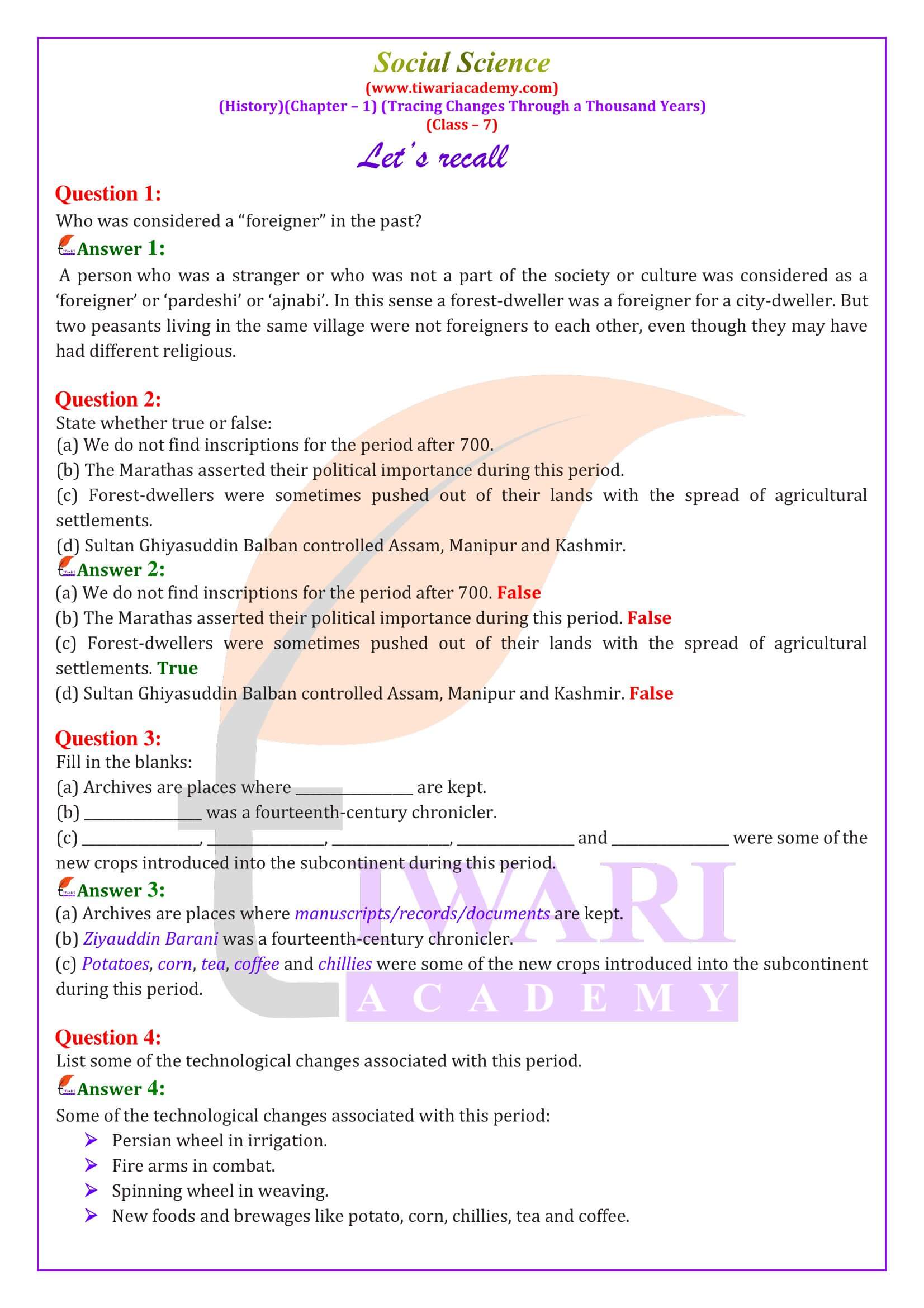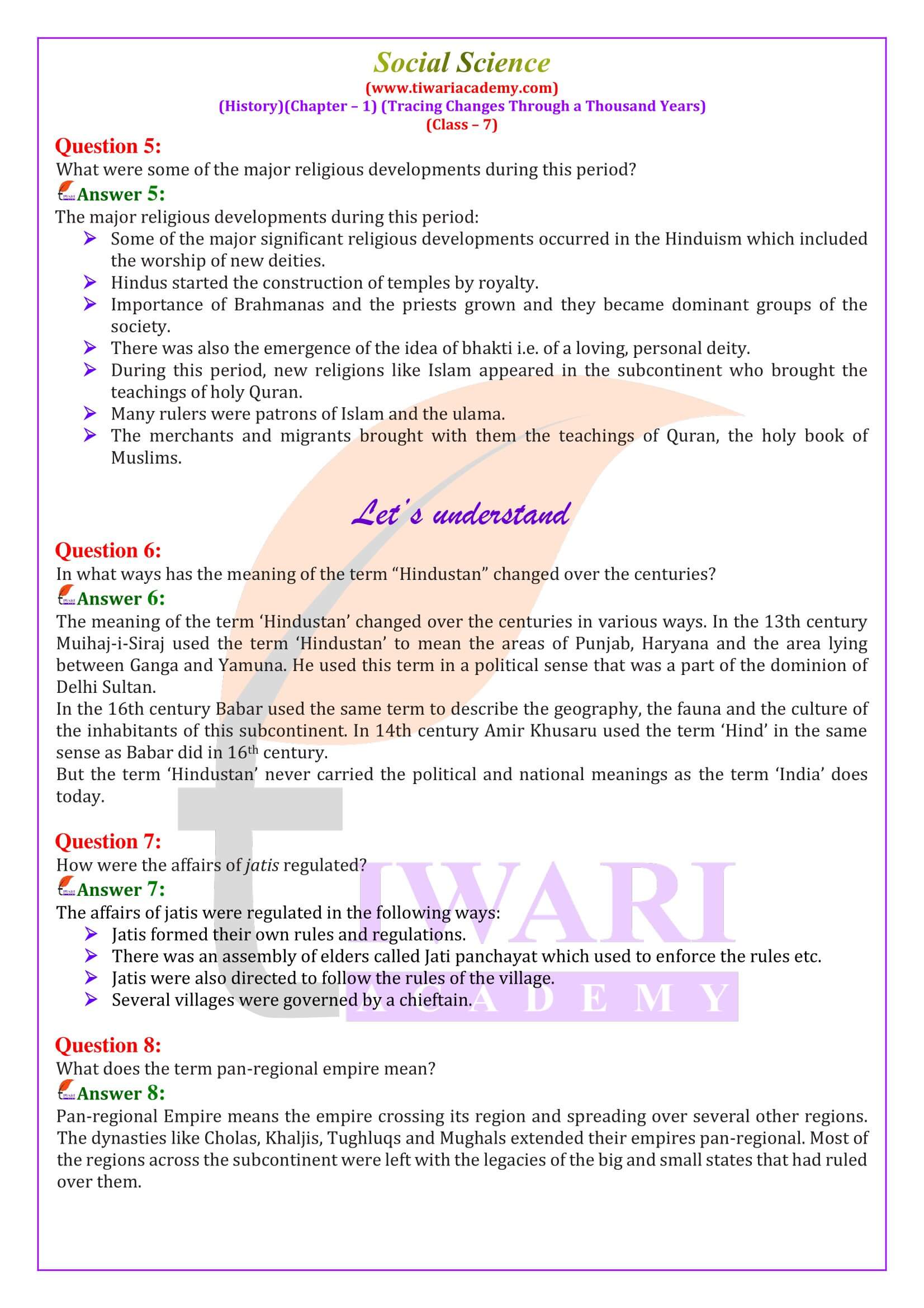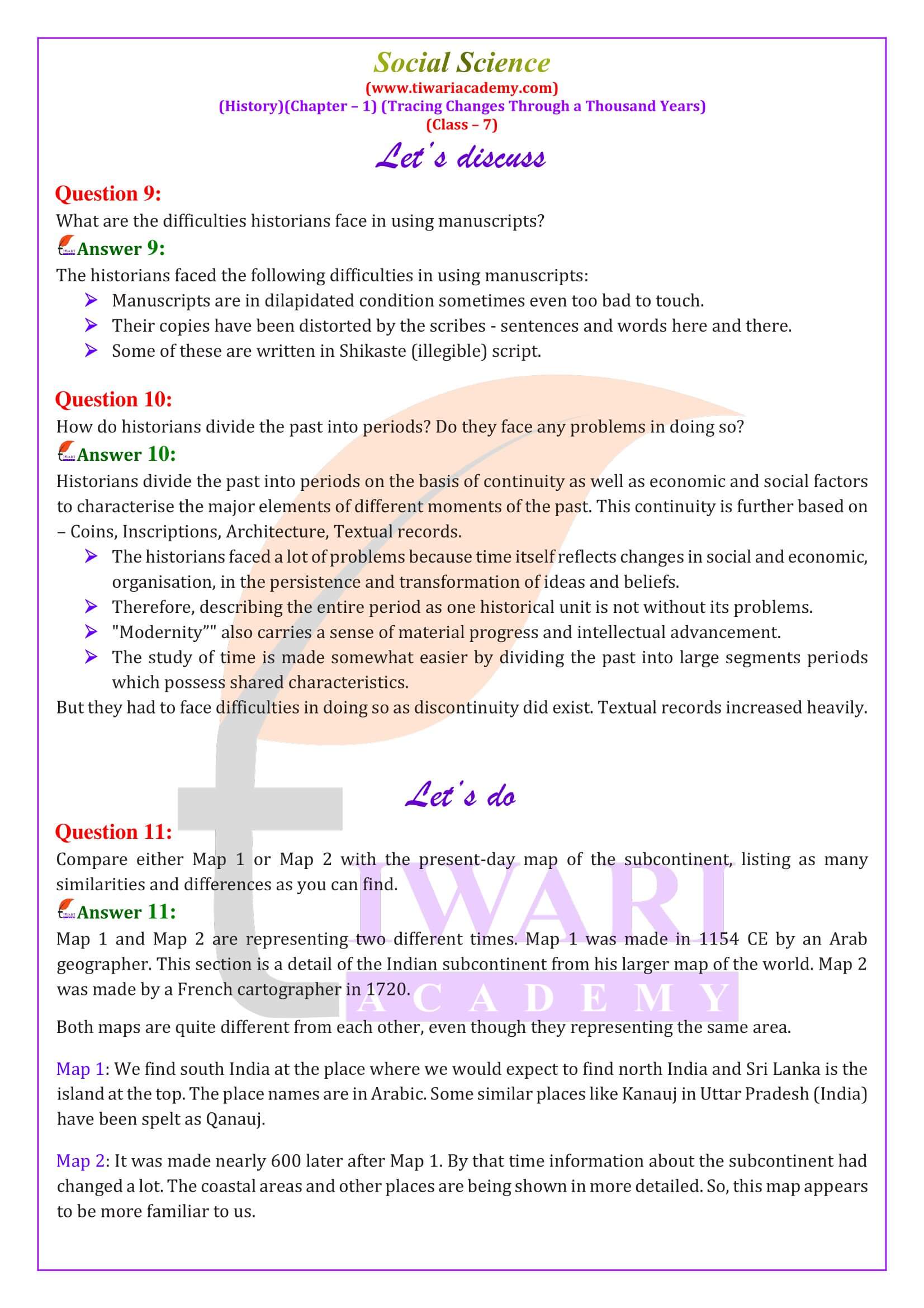NCERT Solutions for Class 7 Social Science History Chapter 1 Tracing Changes Through a Thousand Years in English Medium or Hindi Medium free to View online or download in PDF format updated for 2025-26. All the NCERT Solutions 2025-26 are based on latest NCERT Books for the academic session 2020–2021. Answers are explained in simple language so that student can understand easily.
NCERT Solutions for Class 7 Social Science History Chapter 1
| Class: 7 | History |
| Subject: | Social Science |
| Chapter 1: | Tracing Changes Through a Thousand Years |
| Academic Session: | 2025-26 |
| Medium: | Hindi and English Medium |
Class 7 History Chapter 1 Question Answers
CBSE Solutions for Class 7 Social Science History Chapter 1 Tracing Changes Through a Thousand Years is given below in updated form for session 2025-26. Download these solutions for offline use or use as it is without downloading online.
Important Notes on 7th History Chapter 1
When historians read documents, maps and texts from the past they have to be sensitive to the different historical backgrounds – the contexts – in which information about the past was produced.
Historical records exist in a variety of languages which have changed considerably over the years. Medieval Persian, for example, is different from modern Persian.
While the idea of a geographical and cultural entity like “India” did exist, the term “Hindustan” did not carry the political and national meanings which we associate with it today.
In the medieval period a “foreigner” was any stranger who appeared say in a given village, someone who was not a part of that society or culture. (In Hindi the term pardesi might be used to describe such a person and in Persian, ajnabi.) A city-dweller, therefore, might have regarded a forest-dweller as a “foreigner”, but two peasants living in the same village were not foreigners to each other, even though they may have had different religious or caste backgrounds.
Class 7 Social Science – History Chapter 1 – Important Questions
Who was considered a “foreigner” in the past?
A person who was a stranger or who was not a part of the society or culture was considered as a ‘foreigner’ or ‘pardeshi’ or ‘ajnabi’. In this sense a forest-dweller was a foreigner for a city-dweller. But two peasants living in the same village were not foreigners to each other, even though they may have had different religious.
State whether true or false: We do not find inscriptions for the period after 700.
We do not find inscriptions for the period after 700. False
Fill in the blank: Archives are places where _________________ are kept.
Archives are places where manuscripts/records/documents are kept.
List some of the technological changes associated with this period.
Some of the technological changes associated with this period: Persian wheel in irrigation. Fire arms in combat. Spinning wheel in weaving. New foods and brewages like potato, corn, chillies, tea and coffee.
What were some of the major religious developments during this period?
The major religious developments during this period: Some of the major significant religious developments occurred in the Hinduism which included the worship of new deities. Hindus started the construction of temples by royalty. Importance of Brahmanas and the priests grown and they became dominant groups of the society. There was also the emergence of the idea of bhakti i.e. of a loving, personal deity. During this period, new religions like Islam appeared in the subcontinent who brought the teachings of holy Quran. Many rulers were patrons of Islam and the ulama. The merchants and migrants brought with them the teachings of Quran, the holy book of Muslims.
In what ways has the meaning of the term “Hindustan” changed over the centuries?
The meaning of the term ‘Hindustan’ changed over the centuries in various ways. In the 13th century Muihaj-i-Siraj used the term ‘Hindustan’ to mean the areas of Punjab, Haryana and the area lying between Ganga and Yamuna. He used this term in a political sense that was a part of the dominion of Delhi Sultan. In the 16th century Babar used the same term to describe the geography, the fauna and the culture of the inhabitants of this subcontinent. In 14th century Amir Khusaru used the term ‘Hind’ in the same sense as Babar did in 16th century. But the term ‘Hindustan’ never carried the political and national meanings as the term ‘India’ does today.
How were the affairs of jatis regulated?
The affairs of jatis were regulated in the following ways: Jatis formed their own rules and regulations. There was an assembly of elders called Jati panchayat which used to enforce the rules etc. Jatis were also directed to follow the rules of the village. Several villages were governed by a chieftain.
What does the term pan-regional empire mean?
Pan-regional Empire means the empire crossing its region and spreading over several other regions. The dynasties like Cholas, Khaljis, Tughluqs and Mughals extended their empires pan-regional. Most of the regions across the subcontinent were left with the legacies of the big and small states that had ruled over them.
What are the difficulties historians face in using manuscripts?
The historians faced the following difficulties in using manuscripts: Manuscripts are in dilapidated condition sometimes even too bad to touch. Their copies have been distorted by the scribes – sentences and words here and there. Some of these are written in Shikaste (illegible) script.
How do historians divide the past into periods? Do they face any problems in doing so?
Historians divide the past into periods on the basis of continuity as well as economic and social factors to characterise the major elements of different moments of the past. This continuity is further based on – Coins, Inscriptions, Architecture, Textual records. The historians faced a lot of problems because time itself reflects changes in social and economic, organisation, in the persistence and transformation of ideas and beliefs. Therefore, describing the entire period as one historical unit is not without its problems. “Modernity”” also carries a sense of material progress and intellectual advancement. The study of time is made somewhat easier by dividing the past into large segments periods which possess shared characteristics. But they had to face difficulties in doing so as discontinuity did exist. Textual records increased heavily.
Find out where records are kept in your village or city. Who writes these records? Is there an archive? Who manages it? What kinds of documents are stored there? Who are the people who use it?
In our village, records are kept in the Panchayat house. Gram Sevak (a government employee) writes these records. Yes, there is a room contains so many old records about our village. All the records are managed by Sarpanch (the head of the village). Documents related to land of village, dates of birth and deaths, data of health centre, counting of public properties in the village, etc. are stored in archive. The villagers use it as per requirement. According to need, the certificates are issued to the villagers on the basis of these records.
Compare the following
(1) In the middle of the thirteenth century a scholar wanted to copy a book. But he did not have enough paper. So he washed the writing off a manuscript he did not want, dried the paper and used it.
(2) A century later, if you bought some food in the market you could be lucky and have the shopkeeper wrap it for you in some paper.
Manuscripts were collected by wealthy people, rulers, monasteries and temples. They were placed in libraries and archives. These manuscripts and documents provide a lot of detailed information to historians but they are also difficult to use.
The fourteenth-century chronicler Ziyauddin Barani wrote his chronicle first in 1356 and another version two years later. The two differ from each other but historians did not know about the existence of the first version until the 1960s. It remained lost in large library collections.





